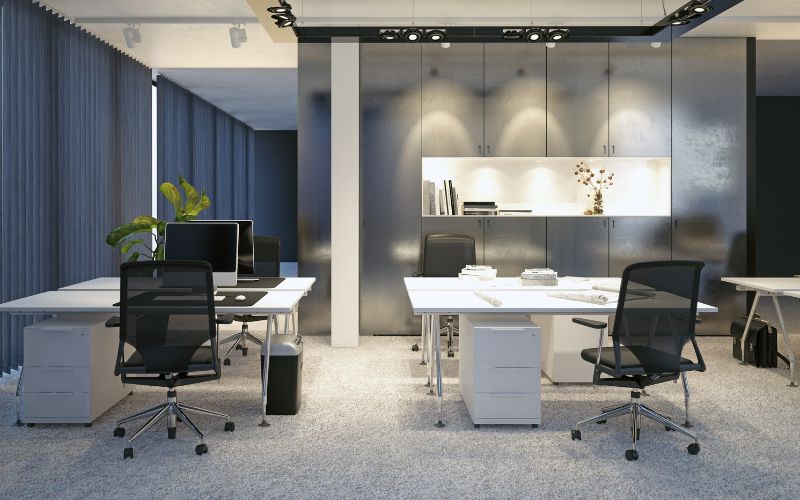How to Design Break Rooms and Common Areas that Your Employees Will Love

A great workplace isn’t just about desk layouts and productivity tools. Employees also need spaces where they can recharge, relax, and connect with one another. That’s why break rooms and common areas are so essential. When these spaces are well-designed, they give employees a chance to unwind and come back to work feeling refreshed. From using the right furniture to creating a cozy vibe, here’s how to design break rooms and common areas that your employees will actually want to spend time in.
Why Break Rooms and Common Areas Matter
Everyone needs a break during a busy day, and a welcoming break room or common area can make all the difference in creating a positive work environment. Not only can these spaces help employees relax, but they can also build team morale by providing a spot for casual conversations and quick check-ins with colleagues. When employees feel comfortable and supported, productivity can increase, and overall job satisfaction improves.
Tips for Designing Break Rooms Employees Love
1. Choose Comfortable, Functional Furniture
Furniture plays a huge role in how a break room feels. Comfortable seating options like sofas, cushioned chairs, and even a few recliners can help create a relaxed atmosphere. Look for options that are easy to rearrange, which allows employees to sit together or find a quiet corner on their own. You might consider working with an office furniture warehouse to find quality pieces that fit your space and budget. The right furniture helps people feel more comfortable, making them more likely to use the space.
2. Incorporate a Variety of Seating Styles
In addition to comfortable seating, think about different seating options to accommodate different activities. Cafeteria-style tables are great for lunch breaks, while high-top tables or stools create a modern, social vibe. Adding cozy nooks with single chairs and small tables gives introverted employees a more private option, too. Having a variety of seating styles can make the break room appeal to all kinds of personalities and preferences.
3. Add Elements of Nature
Studies show that adding natural elements can boost mood and even reduce stress. Plants, wood finishes, and plenty of natural light can help create a refreshing environment. Try to place a few indoor plants around the space—they’re not only visually appealing but also improve air quality. Large windows or even a skylight, if possible, can bring in natural light and make the room feel more open and airy.
4. Set Up Entertainment and Relaxation Options
A well-loved break room often has more than just a place to sit and eat. Consider adding a few entertainment options like a TV, game consoles, or even a foosball table. A bookshelf with magazines and books can also be a nice touch. These options allow employees to take a true mental break from work, which can help them return to their tasks feeling refreshed and more productive.
Creating a Common Area for Connection and Collaboration
While break rooms focus on relaxation, common areas often serve as a place for socializing and even casual brainstorming sessions. These spaces don’t always need walls—open areas with comfortable furniture and nearby tables for laptops are often enough.
1. Use Versatile, High-Quality Furniture
Common areas should have furniture that’s comfortable but also durable. Since these spaces often get a lot of use, choosing quality pieces that can handle daily wear and tear is essential. A local office furniture warehouse can be a great source of sturdy, comfortable chairs, modular sofas, and movable tables. This way, your team can easily rearrange the space as needed for group discussions, private chats, or small team meetings.
2. Include Collaborative Tools
Adding some collaborative tools to your common area can encourage casual teamwork. A whiteboard, sticky notes, or even a digital screen can make it easy for teams to share ideas and brainstorm. Including a charging station with multiple outlets for laptops and phones can also make the space more practical for modern work needs.
3. Design with Personality and Color
A common area is a great spot to bring in fun decor and vibrant colors. Bright walls, artwork, or even a mural can make the area feel inviting and inspire creativity. If your office has a particular brand color, try to add subtle accents in the common area. You don’t want the space to look too corporate—this is a place for employees to let loose a little and get inspired!
Final Tips for Designing Amazing Employee Spaces
Creating break rooms and common areas that employees love isn’t just about the furniture and decor. Here are a few final ideas to help these spaces become a true part of your workplace culture:
- Encourage Feedback: Ask employees for input on what they’d like to see in these spaces. They may suggest things you hadn’t thought of!
- Keep It Clean: A tidy space is more inviting. Make sure there’s a system in place for keeping the break room clean and organized.
- Provide Snacks or Beverages: Even a small selection of coffee, tea, and snacks can make a break room more appealing. If possible, consider adding a fridge for employees to store their own snacks.
Conclusion
Designing a welcoming break room and common area can make a huge difference in your team’s experience at work. With a few thoughtful design choices and some quality furniture from an office furniture warehouse, you can create spaces that help employees feel more comfortable, valued, and ready to tackle their day. Whether they’re recharging, socializing, or brainstorming, these areas become the heart of a workplace where people are happy to be.